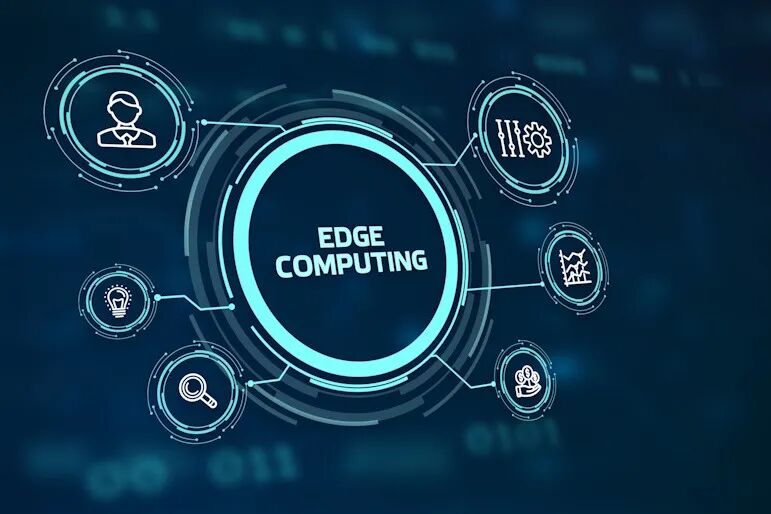Click the blue text to follow us
This public account is a non-profit MEMS technology dynamic and industry reporting platform under the Guangdong Microtechnology Industrial Research Institute. We publish in-depth reports on MEMS, track industry dynamics, and provide technical popularization every week. This article is an in-depth report.
One of the main visions of 5G is edge computing, sometimes referred to as Mobile Edge Computing (MEC). The idea is that Mobile Network Operators (MNOs) can deploy computing resources closer to their base stations, thereby providing ultra-low latency and allowing MNOs to charge more for premium services.
Fast forward five years, and MNOs’ edge computing deployments are virtually non-existent. Only a few operators have attempted to collaborate with search engine companies to send data to these companies’ cloud centers instead of using their own computing resources.
Instead, the popular model remains that telecom networks transmit data to “peering points” (commonly known as Internet Exchange Points), where multiple Internet Service Providers and networks connect to exchange traffic. From there, data is sent to data centers owned by hyperscale enterprises for processing, with responses returning via the same path.
1
Why Has the Concept of Edge Computing Not Taken Off?
Science
Technology
Edge computing reduces latency by decreasing the distance data must travel to be processed. However, fiber optic cables transmit data at about 200 km/ms. A data center located 100 kilometers away only adds 1 millisecond to the response time.
Current 5G networks typically have a latency of 30-40 milliseconds, with the best dedicated networks achieving around 10 milliseconds. Data processing itself usually takes several milliseconds, especially when video compression is involved. Reducing 1 millisecond by bringing computation closer to the device makes almost no meaningful difference.

Moreover, in most regions, there may be a major city within a 1 millisecond range that already houses hyperscale data centers. These large facilities offer better economies of scale, and hyperscale operators are better positioned than MNOs to sell computing services. Thus, today’s “edge” solutions largely reflect traditional models, where MNOs transmit traffic to peering points and then process it in hyperscale enterprise data centers.
One exception is dedicated 5G networks, which route traffic to the IT systems of the dedicated network owner. While this can technically be called edge computing, functionally it is just another form of peering connection, this time into a local IT network.
Recently, discussions about MEC have quieted down as MNOs have realized that edge computing is neither a viable deployment service nor an attractive revenue opportunity. In fact, MNOs are increasingly centralizing their computing needs, consolidating baseband processing from multiple base stations into centralized units rather than deploying computing resources at the network edge.
2
Will 6G Change Anything?
Science
Technology
At this stage, what 6G will be remains uncertain. MNOs are advocating for “pure software” updates to reduce operational costs, while manufacturers are promoting “super 5G” with faster speeds and lower latency. Concepts such as sensing and AI-native capabilities are also under discussion, but it remains unclear whether new spectrum will be allocated.
For edge computing to gain traction, several conditions need to be met:
-
New applications requiring latency below 5 milliseconds
-
Willingness to pay more for such ultra-low latency services
-
Additional spectrum allocation to support low-latency air interfaces
-
Sufficiently widespread 6G deployment to make edge computing feasible across regions
Currently, all of these seem unlikely.
Most proposed 6G applications are merely reiterations of the promises made for 5G, many of which have yet to be fulfilled. Consumers and businesses show little interest in paying extra for 5G services, and acquiring additional spectrum for 6G is becoming increasingly difficult. In fact, geographically, only 20% of countries/regions have deployed mid-band 5G (3.5 GHz), indicating that 6G coverage will be even more limited.
3
Do AI and Sensing Change the Game?
Science
Technology
Two new applications frequently discussed in relation to 6G are sensing and AI. The market demand for sensing applications remains unclear, and implementing sensing within 6G may require high-frequency spectrum that is less suitable for communication.
AI applications typically require rapid response times, which could justify edge computing. However, most AI workloads either run directly on mobile devices (e.g., AI assistants, visual processing) or require high-performance processing best handled in large data centers. There seem to be few AI applications that require millisecond-level responses, and there is no strong market demand to pay extra for an additional 1 millisecond acceleration through edge computing.

Some industry leaders suggest that MNOs sell their “spare” computing resources for AI workloads, utilizing unused capacity in their network baseband processing, but this concept has flaws. Hyperscale data centers also have excess capacity during off-peak hours, making MNO computing resources unnecessary. Additionally, the complexity of dynamically reallocating computing power between AI workloads and wireless network functions is very high.
Therefore, offloading AI workloads to MNOs offers little added value and is unlikely to take off.
4
The Edge Still Belongs to the Cloud
Science
Technology
For a long time, the telecom industry has tried to compete with hyperscale enterprises by offering value-added services, but often unsuccessfully. MNOs have struggled to gain traction in areas dominated by hyperscale providers and OTT providers, and edge computing is no exception.
Recent years have shown that the true “edge” will continue to reside in hyperscale data centers located in major urban centers, rather than at the network edge.
5
Local Practices and Breakthroughs in China
Science
Technology
As global edge computing and 6G advancements face obstacles, China is exploring differentiated development paths through technology innovation that aligns with industrial needs.
Edge computing finds core scenarios in the industrial Internet. Traditional edge computing has limited advantages due to 1-10 millisecond latency, leading to slow global deployment, but the digital transformation of Chinese manufacturing has created a strong demand for real-time control and data privacy. Haier factories utilize edge computing nodes to locally process device data, improving production line efficiency by 8% and reducing energy consumption by 15%, upgrading from a network-assisted tool to a core component of production. China Mobile’s “Jiutian” platform builds a “cloud-edge-end” collaborative architecture, connecting over 200,000 edge nodes, covering cloud-inaccessible scenarios such as mines and ports. By 2024, the industrial edge computing market is expected to reach 12 billion yuan, with an annual growth of 42%, indicating significant B-end demand.

6G development breaks out of the “super 5G” framework, building unique advantages through technology integration. The Zijinshan Laboratory’s 6G intelligent sensing integration experimental network achieves centimeter-level positioning and millisecond-level processing, supporting scenarios such as low-altitude logistics; China Star Network’s 13,000 low-orbit satellites collaborate with ground networks to solve coverage issues in remote areas, with integrated testing of air-ground-space completed in Xiong’an by 2024. China holds 40% of 6G patents and leads 30% of international standard proposals, with technologies such as terahertz communication forming reserves, planning for commercialization by 2030.
The value of technology is reconstructed in scenarios. Edge computing addresses the need for localized processing of industrial data through “cloud-edge collaboration”; Shenzhen Port uses it to improve container recognition efficiency by 40% and reduce costs by 30%; 6G becomes the infrastructure for the digital economy, with a Zhejiang factory achieving a defect detection rate of < 0.1% through 6G networks and edge AI, and remote medical services in mountainous Sichuan relying on 6G satellites achieving latency < 10ms.
Ecological construction relies on collaboration among “government, industry, academia, research, and application”. Policies incorporate edge computing into new infrastructure, reserving spectrum for 6G and piloting; universities tackle core technologies (such as terahertz chips), enterprises convert products (such as Huawei’s 6G terminals), and industries feed back demand (such as Baosteel’s industrial private network indicators). This ecosystem avoids zero-sum competition and fosters an innovation multiplier effect.
China’s practices show that technology implementation does not need to be confined to performance comparisons in generic scenarios but should explore local pain points and build differentiated routes. From industrial edge nodes to air-ground-space 6G networks, China defines technology through scenarios and incubates value through ecosystems, providing a “diverse path” sample for the world, indicating that future competition will shift towards a system capability comparison of “technology – scenario – ecosystem”.
END
Original Author: William Webb
Compiled and revised by: Smart Sensor Network
Reprinting is welcome, please indicate the source!